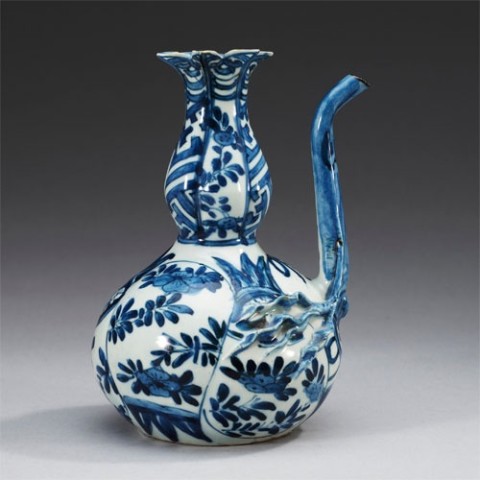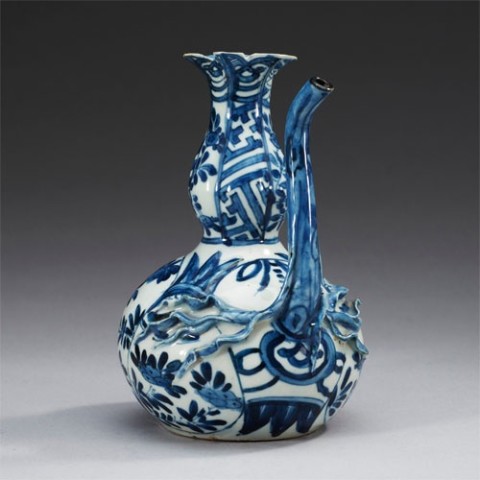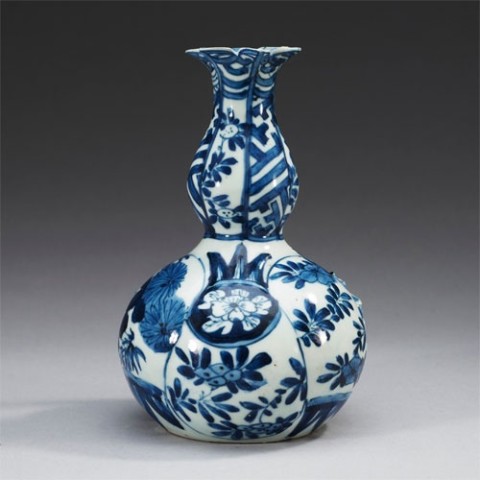Further images
Of globular body and bulging neck, giving it a double-gourd shape, with a thin, long spout, curved at the end and attached to the body with leaves and branches moulded in relief, the mouth-rim star-shaped to resemble the top of a pomegranate, painted in shades of underglaze blue enamels with on the globular body moulded panels in the shape of pomegranates alternately pointing upwards and downwards and decorated with stylised flowers, grasses and ruyi-heads, the bulging neck with long moulded panels of alternately key-pattern or floral decorations finished at the top with a stylised overlapping pattern, the thin and long spout painted to resemble wood with small holes and lines like in the bark of a tree, the inside of the star-shaped mouthrim painted in blue with lines to resemble petals, the glazed base slightly recessed.
Provenance
The Thomax Collection
Exhibitions
Arabia Museum, Helsinki, Finland, 1994.
Literature
For an almost identical example see Maura Rinaldi, Kraak Porcelain - A Moment in the History of Trade, Bamboo Publishing Ltd, London 1989, pl. 228, p. 178-179, from the collection of the Fondation Custodia (Coll. F. Lugt), Institut Neerlandais, Paris (Inv. 6267). Rinaldi discusses these types of Kendis here and she quotes Robinson and Kidney (1984): "Kendis with thin curved spouts appeared in China as early as the fourteenth century, but by the seventeenth century, the spout has lengthened considerably and resembles the spouts on Middle Eastern ewers", p. 177. She also points out two peculiarities always recurring with this type of kendis, the first is that the spouts are often twisted to the left, and that they have a star-shaped mouthrim which "probably gave rise to the popular name of these vessels, 'pomegranate eweres'." p. 177. She also discusses the dating of this kind of ewer borne out by the inclusion of a kendi of this form amongst the cargo of the San Diego, a Spanish galleon which sank off the coast of The Philippines in 1600 (see Carré, Desroches et Goddio, Le San Diego, Paris, 1994, catalogue no. 6, p. 338).
Another almost identical example is in the Sir Percival David Collection, British Museum, Reg. no. PDF,A.659,and illustrated in Medley, Margaret, Illustrated Catalogue of Underglaze Blue and Copper Red Decorated Porcelains, London, University of London, Percival David Foundation of Chinese Art, School of Oriental and African Studies, 1976, p. 45 and in Pierson, Stacey, Illustrated Catalogue of Underglaze Blue and Copper Red Decorated Porcelains in the Percival David Foundation of Chinese Art, London, University of London, Percival David Foundation of Chinese Art, School of Oriental and African Studies, 2004, p. 65.
Another from the Franks Collection is illustrated by Jessica Harrison-Hall, Ming Ceramics in the British Museum, London, 2001, pp. 282 and 283, no. 11:15 and a further is in the Princessehof Museum, Leeuwarden and illustrated by D.F. Lunsingh Scheurleer, Chinese Export Porcelain - Chine de Commande, London, 1974, fig 23.
The Thomax collection was originally formed by the Art Collector and connoisseur Professor Leif Sourander, Åbo, Finland from the 1960's to the 1990's. The collection was exhibited at the Arabia Museum in Helsinki during the period 2/9 - 30/10 1994. The Exhibition Catalogue was written by Bo Gyllensvärd, Heikki Hyvönen, Marjut Kumela, Leif Sourander and Jouko Tiainen. The collection was then sold as a whole to the previous owner and thence by descent.






